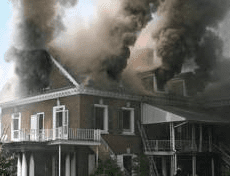 During an open conference call recently, I had the opportunity to discuss situational awareness challenges and opportunities (which, by the way… was really enjoyable) I had a chief officer from Wisconsin (thanks Lance) ask a question about company officer priorities on sizing up a residential dwelling fire. It’s a question I get asked often and have built the answer into the ten best practices I share at the end of the Fifty Ways to Kill a First Responder program. So, if you have attended that program, this will be a nice refresher for you. If you haven’t, then consider using this list to help in your initial size up.
During an open conference call recently, I had the opportunity to discuss situational awareness challenges and opportunities (which, by the way… was really enjoyable) I had a chief officer from Wisconsin (thanks Lance) ask a question about company officer priorities on sizing up a residential dwelling fire. It’s a question I get asked often and have built the answer into the ten best practices I share at the end of the Fifty Ways to Kill a First Responder program. So, if you have attended that program, this will be a nice refresher for you. If you haven’t, then consider using this list to help in your initial size up.
First, before I jump into the list, I want to share a little B.S. with you… Brain Science. Program attendees know that I rarely make recommendations about why responders should do something a certain way without some tie-in to the neuroscience that supports my claims. I wish more instructors would do the same. We’d have less anecdotal tales being told and more lessons being taught that are backed by research. Ok… my rant is over.
Here’s the 4-1-1 on the B.S.: [tweet this] The human brain can take in, process, comprehend and recall a very limited amount of unrelated information. Complicating this is the vulnerability of the short-term memory (also known as working memory) to quickly forget. Quickly being defined as: Within seconds. As a side note, the stability of short-term memory can be improved by repetition and it tends to hold on to things that are emotional.
So, how many pieces of unrelated information can the average human’s short-term memory handle? About seven (give or take two). That’s not very many pieces of information considering how complex emergency scenes can be. And, to complicate matters, stress can reduce that number to five (give or take two). This point becomes ridiculously important to understanding our limitations and humans… and commanders.
First-arriving officers, under stress, can process about five pieces of information coherently. [tweet this] And, as you know, there may be dozens (maybe even hundreds) of pieces of information coming your way. Some are critical. Some are not. The trick, if there is a trick, is to identify, in advance, those pieces of information that are most important. Seek them out, and use them as the foundation for good decision making.
For example, at a structure fire, the short list of critical clues and cues might include:
Smoke and fire conditions: What is the color, volume, velocity and density of the smoke and fire. And, of course, understanding what that means in relation to what is burning, where it is burning, how hot it’s burning and where it is traveling to.
The building construction and decomposition: What is the building made out of and where is the building at in the process of falling down? Make not mistake about it. A building on fire is in the process of falling down. The forces of gravity are in play and when the building weakens enough, gravity will win and the building will fall down. To understand this risk is to understand building construction and building decomposition.
Risk-benefit assessment: Are there savable lives in the structure. Too often the casualty of structural fires are firefighters engaged in the act of searching a vacant structure or one where there are no savable lives. Firefighters are sworn to protect lives and property but not all lives and property can be saved.[tweet this] It’s just a fact.
Assessing resource needs and abilities: Are there enough resources assembled to perform the tasks needed to overwhelm the fire? To determine this requires and understanding of the physics of fire and water (knowing how much water it takes to put out a certain volume of fire) and it takes knowing something about the abilities of the personnel assembled to perform the tasks. Not all crews are created equal and to fight all fires as if all crews are high quality, “A-team” performers is unrealistic.
Chief Gasaway’s Advice
 Ensure your size up includes these four things.
Ensure your size up includes these four things.
1. Smoke and fire assessment
2. Building construction and decomposition assessment
3. Risk-benefit assessment
4. Resource assessment
Action Items
 1. What is the most challenging part of the size-up process for you?
1. What is the most challenging part of the size-up process for you?
2. Do you ever find yourself being overwhelmed with information? What can you do to resolve this?
3. Have you ever overlooked an important piece of information, but were so overwhelmed that you didn’t realize it at the time?
________________________________________________________________
The mission of Situational Awareness Matters is simple: Help first responders see the bad things coming… in time to change the outcome.
Safety begins with SA!
________________________________________________________________
Share your comments on this article in the “Leave a Reply” box below. If you want to send me incident pictures, videos or have an idea you’d like me to research and write about, contact me. I really enjoy getting feedback and supportive messages from fellow first responders. It gives me the energy to work harder for you.
Thanks,
Email: Support@RichGasaway.com
Phone: 612-548-4424
Facebook Fan Page: www.facebook.com/SAMatters
Twitter: @SAMatters
LinkedIn: Rich Gasaway
YouTube: SAMattersTV
iTunes: SAMatters Radio
iTunes: SAMatters



Pingback: Understanding Stress – Part 4: Hyper Vigilance | Situational Awareness Matters!™
Pingback: Understanding Stress - Part 4: Hyper Vigilance | Situational Awareness Matters
Pingback: The Secret of Defeating Your School Stress – pewswan